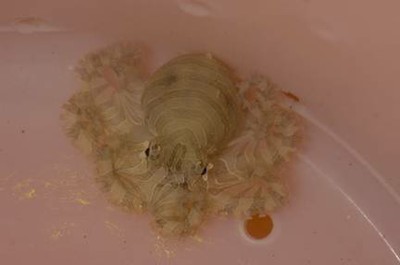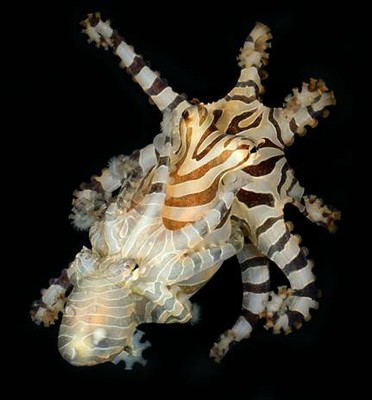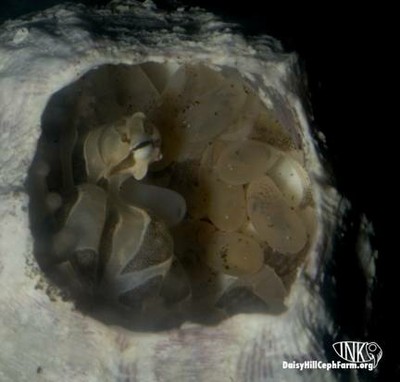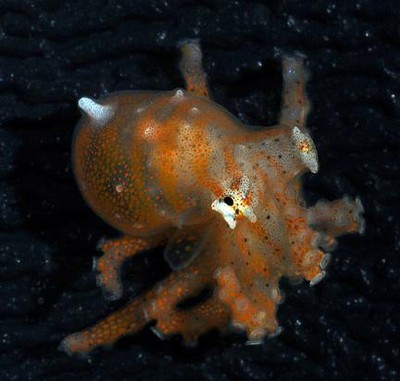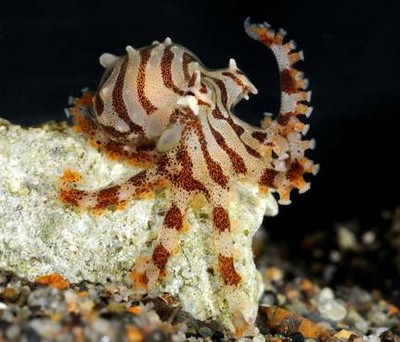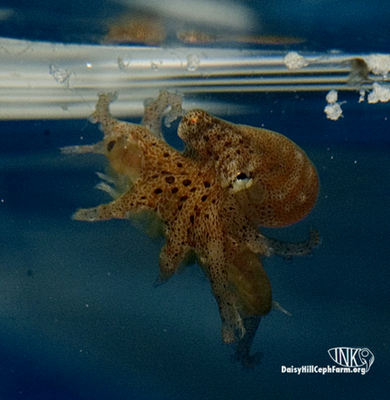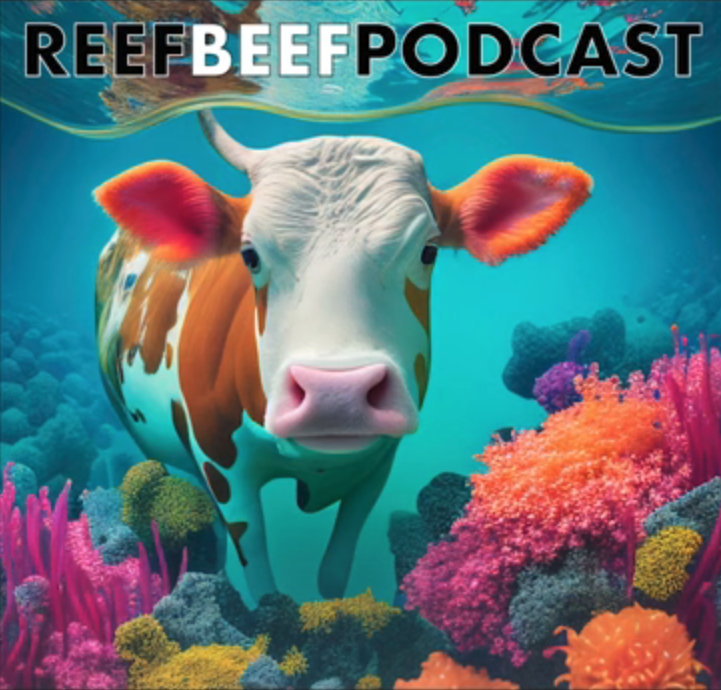From Advanced Aquarist Online and Reef Life Magazine
In recent years there has been much public interest in the so-called ‘zebra’ octopuses – Wunderpus photogenicus and Thaumoctopus mimicus. And with good reason, as these animals can be stunning in coloration, patterning and displays. As their common moniker implies, these octopus can display distinctive black and white stripes over their mantle and arms. But there is another ‘zebra’ octopus that is rarely seen which may turn out to be even more fascinating than its better known cousins – the pygmy octopusOctopus chierchiae.
Nuts and bolts
Octopus chierchiae is a striking, small octopus. The skin of the adult is usually a creamy color with dark bands bordered by white all over the body and arms. At times, the same individual bands can fade so the whole animal appears creamy with creamy stripes. At other times, that same specimen may become translucent, revealing the branchial, or gill, hearts beating in the animal’s pointed mantle. Finally, that same specimen might a uniform, dark brown. The skin itself alternates between a smooth and a bumpy texture, and there are star shaped papillae around each eye as well as prominent papillae towards the tip of the mantle.
Octopus chierchiae occurs along the pacific coast of Panama and Nicaragua, living in the low inter-tidal zone where they may be periodically exposed to air and may survive in water that collects in rock cavities between tides. Being from this zone, it may be that this species is tolerant of a wide range of temperatures and salinities. Although they have been described in one of the few scientific papers about them as ‘common’, they may not be, or they may simply only be common at certain times of year. We simply don’t know because the science hasn’t been done. One expedition to collect these animals for research was unable to obtain a single specimen. If these octopuses are indeed not common, negative impact on wild populations due to collection is a very real possibility, as these animals are recognizable, andeasy to collect due to the environment they live in.
The lifespan of Octopus chierchiae is currently unknown, but thought to be roughly a year. The longest lived wild caught animal was kept alive for approximately 8 months.
One of the most astonishing features of this species is the female’s ability to lay multiple clutches of eggs over its lifetime. The reproductive strategy for most octopuses is semelparous, laying many small eggs at once and then dying. The small eggs almost always hatch as planktonic paralarvae and are essentially impossible to raise in captivity (although there has recently been some small success in that area). Octopus chierchiaehowever, is iteroparous, and it lays several, smaller clutches of eggs before dying. What makes Octopus chierchiae even more attractive from a breeding standpoint is that the eggs are large, and the hatchlings emerge essentially as miniature adults which makes raising the hatchlings possible in captive environments.
Females are larger than males, reaching a dorsal mantle length of 25mm and 18 mm respectively. The males have a hectocotylus, or grove, on the third right hand arm when the animal is viewed from above that is used to pass sperm packets to the female. It also appears that the males have ‘fringing’ along the tips of the arms that is absent in females.
It is also possible these animals are toxic in some way – their striking coloring and patterning seems very much like warning to would be predators. However, whether the bite is toxic or the flesh is toxic is a question that will have to wait for further research.
History
Octopus chierchiae was first briefly described by G Jatta in 1889. Most of what we know about their lifecycle and behavior comes from a paper written in 1984 by Arcadio F. Rodaniche, along with some first hand observations by cephalopod researcher Dr Roy Caldwell. In the early 1970’s Dr. Caldwell collected severalOctopuschierchiae while doing stomatopod research in Panama, and treated them as a curiosity. This experience was partly responsible for Dr. Caldwell becoming interested in studying pygmy octopuses. It was he who later returned to Panama to collect Octopus chierchiae and was unable to find a single specimen.
Since then, Dr Caldwell has obtained specimens of Octopus chierchiae sporadically, and they have leaked into the pet trade from time to time. The issue with getting them is there are few marine ornamental collectors in that part of South America, and they don’t collect and ship in a consistent manner for any animals, never mind a ‘specialty’ animal like a cephalopod. Dr. Caldwell wrote about them once onwww.TONMO.com (the online source for all things ceph related), but since they were so rare in the trade and in research, I never imagined I would be able to work with them.
As luck would have it…
In early April 2008, I received an email from a supplier asking if I was interested in some zebra octopus they had received from Indonesia. One was a Wunderpus, but the other was clearly something different. It looked like Octopus chierchiae. Later discussion revealed that the specimen did not come from Indonesia, but rather arrived as a stow away in a gastropod shell in a shipment from Nicaragua. I asked for the animal to be shipped to me and went about modifying part of my cuttle system into an octopus system in anticipation of its arrival.
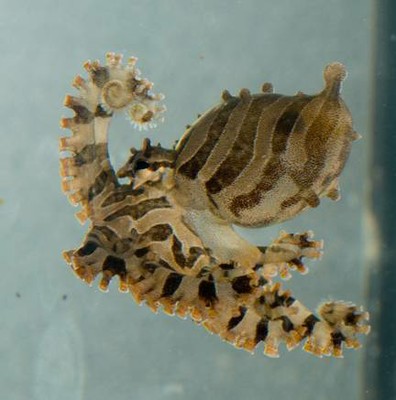
Octopus are escape artists, inter-tidal octopus like Octopus chierchiae even more so because they are used to crawling around in areas without much water. They can also be cannibalistic, so keeping them separate is imperative. Luckily, the modifications were fast and straightforward because the system was mature, with Carib-Sea ‘mineral mud’ substrate. All that was needed was some ‘octo proofing’ of part of my cuttle breeding system. The cuttle system was a cube system with the cubes divided by slotted acrylic that an octopus could easily fit though, so I bought some small pored commercially-available aquarium divider material, cut it to size and super glued it in place over the slots while the tank was still full of water. Even though I didn’t think it would be possible for the octopus to escape through the return plumbed into each cube, I also covered the return… the chance simply wasn’t worth taking. I also purchased some large glass tiles to place over each cube and the system was ready to go.
The octopus arrived, was acclimated and introduced into its new home. Its mantle was about 15 mm across, and all of its arms were intact and looked healthy.
I wanted some kind of den or hiding place for the octopus, but wanted to be able to easily check on the animal’s health – and to be sure it hadn’t escaped or died. Some dwarf octopus live in gastropod shells, but such dens would have made it difficult to keep track of the animals because they could easily disappear deep down into the spiral of the shell.. My initial offering, a piece of large vinyl tubing, was ignored, so I replaced it with large individual barnacle shells and the Octopus chierchiae quickly took up residence.
I offered live shore shrimp (Palaemontes v ulgaris) but they were ignored for the first few days, as were local San Francisco bay bait shrimp (Cragnon spp). I collected some local shore crabs (hemigrapsis spp), which were taken with gusto, although that might have been because the octopus were hungry rather than due to a preference for crabs. The crabs stopped struggling within seconds of being bitten which may point to possible toxicity of Octopus chierchiae.
Cephalopood researcher Dr Christine Huffard came byto take a look at the animal and confirm the identification. She alsodetermined that the animal was female. I immediately followed up with the initial supplier, as well as others, asking if they could get more specimens.. If we could get more, not only would we could learn more about them, but we could perhaps establish a breeding population which could benefit both research and hobbyists.
An online retailer had one Octopus chierchiae listed, which I quickly bought. He also told me that they had seen 4 more individuals at their supplier. I immediately sent them more money, but in a heartbreaking turn of events, it turned out that they had escaped into the wholesalers live rock holding tanks… never to be seen again. Fortuitously, when the second Octopus chierchiae arrived it turned out to be a male andDr Caldwell, Dr Huffard and I set up a date the next week to attempt to mate them
I’ll never forget that night, the three of us crowed around a 3 gallon tank, in the dark, with multiple still and video cameras ready to document the cephalopod pornography. When we put the male and female together, they copulated within minutes. The smaller male sized up the female and then quickly jumped on her, inserting his hectocotylized arm into her mantle. The mating lasted several minutes and the animals were then returned to their individual homes. It was like cephalopod Christmas morning.
Here be hatchlings
Two weeks later, a second male arrived, thanks to a donation by a generous and selfless hobbyist. Dr. Caldwell came over to mate the second male to the female. When I went to move the female to the photography tank I discovered a clutch of eggs in her barnacle den.
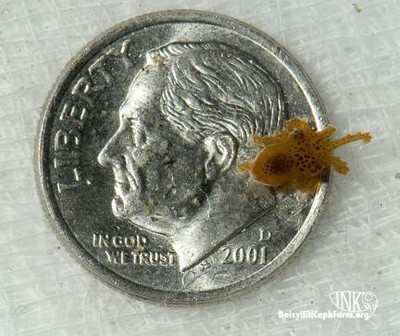
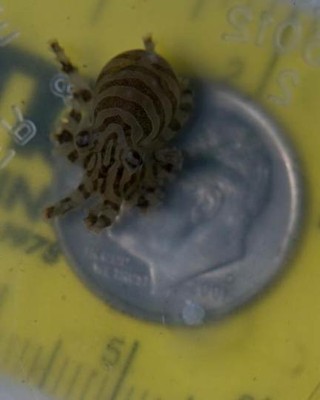
Over the next few days, she tipped her den opening down and would walk around her tank as if she were trying to de-evolve back into a snail. If disturbed, she would use her arms inside the barnacle and against the bottom of the tank to ‘suck’ the barnacle to the bottom of the tank. I gently tried to pull up the den to see what was going on inside, but stopped because it was going to take a great deal of effort to separate it from the tank and I didn’t want to risk damaging her or the eggs.
Over the next several weeks I eagerly awaited hatchlings. I was pleasantly surprised to discover that the female would sneak an arm out from under the barnacle to take freshly killed shrimp; according to Rodaniche the females don’t eat during brooding. While waiting for the eggs to hatch, I prepared for hatchlings.
I built a water table to house individual octopus hatchling containers. I took small, clear plastic containers, cut a slot in their sides and glued netting from a commercially available net breeder over the slots. I drilled a hole in each lid and glued a piece of rigid tubing into the hole. I then attached airline tubing to a valved manifold fed by a small power head. I drilled a second hole in the top of each container for feeding. This set up was inexpensive, allowed me to add containers as necessary, allowed me to control the amount of water in each container, and gave me easy access and easy viewing to each container with minimal stress to the hatchling during feeding.
Finally the first hatchlings arrived. I discovered in them one morning, and found them to be an amazing orange color, very different from the adult coloration. They swam in the water column bouncing up and down like fishing bobbers. Over the next 20 days I discovered hatchlings in 1s and 2s, for a total of 23 hatchlings from the first clutch. I fed them small amphipods collected from the aquarium glass elsewhere in the system, and gave them black airline tubing to use as dens – which they ignored. About half of the hatchlings went to Dr. Caldwell’s lab, where they were kept in glass jars with netting over the mouth to prevent escape in a larger aquarium, and were given calcareous tube worm tubes as dens – which they immediately took to.
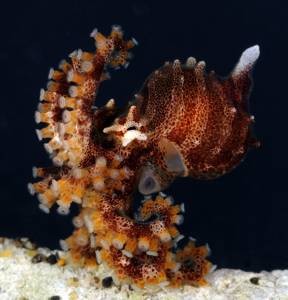
As the hatchlings grew they were given larger amphipods both cultured and collected from around the San Francisco Bay. As mentioned earlier, everyone knows that octopuses are amazing predators, but there is something phenomenal about watching a 5 mm long animal hunt, capture and eat a 7 mm long amphipod.
The extended Cephalopod community
For several years now, Octopus chierchiae have been www.TONMO.com’s most wanted octopus, so the obtaining of specimens and the successful breeding of these animals made for excitement among cephalopod enthusiasts. As it happened, a few more Octopus chierchiae had turned up across the country. Since broodstock is a traditional stumbling block to getting captive cephalopod breeding populations established, I asked all three of the people who had an Octopus chierchiae, to send them to me, letting them know that Dr. Caldwell and I would gladly pay for them. If our breeding project was successful, we would send them hatchlings as replacements. We were able to get two more males from generous hobbyists. There was one hobbyist that had a female and ended up with hatchlings, but wasn’t able to get them into the effort. This was unfortunate because we needed the genetic diversity. The hunt for more animals went on for months, but none were to be found and the South American supplier had ceased shipping.
Some Final Details
- Two of the hatchlings climbed up the side of their containers, and met a grisly, dried out death. Several more of the hatchlings were lost due to an unfortunate ammonia spike, while others were lost to unfortunate salinity drops. Others were lost for unknown reasons.
- The hatchling wet weight at 3 days was 22.3 mg, while at day 123, the wet weight was 330 mg.
- The female was mated to 3 males, resulting in 3 clutches laid and 46 discovered hatchlings (some may have undetected on hatching and escaped into the larger system).
- There were more male hatchlings than females. The longest lived male survived for 340 days, while the longest-lived female lasted 326 days. Both of these far exceed the lifespan of any wild-caught specimen on record.
- Any attempted sibling or oedipal matings resulted in no eggs being laid.
- We were not able to obtain any more specimens, so the effort ended after all the animals died.
In conclusion
Octopus chierchiae is an amazing little animal and is clearly worth further study. Every time I speak to a supplier I ask about getting more from South America, but a year and a half has passed without further specimens. It is my hope that someday we’ll succeed in establishing a viable breeding program, and in the process learn more about this fascinating little ‘zebra’ octopus.
References and Resources
Hard Copy
- Boyle, PR and Rodhouse, P. 2005. Cephalopods: ecology and fisheries. Wiley-Blackwell, 452 pages
- Dunlop, C and King, N. 2008. Cephalopods: Octopuses and Cuttlefish for the Home Aquarium. TFH Publications. 269 pages
- Hanlon, RT and Messenger. 1996. Cephalopod Behaviour. Cambridge University Press. 232 pages
- Rodaniche AF (1984) Iteroparity in the Lesser Pacific Striped Octopus, Octopus chierchiae. (Jatta, 1889). Bull Mar Sci 35:99–104
- Caldwell, Roy. Private communication.
Web
- Octopus chierchiae mating video: http://www.stickycricket.com/aquarium/movies/oc_movie.html
- www.TONMO.com
- www.DaisyHillCephFarm.org
- www.TheCephalopodPage.org
